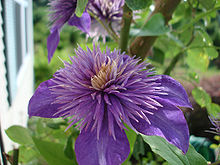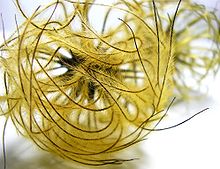- Clematis
-
Clematis Clematis 'Nelly Moser' Scientific classification Kingdom: Plantae (unranked): Angiosperms (unranked): Eudicots Order: Ranunculales Family: Ranunculaceae Subfamily: Ranunculoideae Tribe: Anemoneae Genus: Clematis
L.[1]Species See text.
Synonyms Atragene L.
Coriflora Weber
Viorna Rchb.[1]Clematis (klematis)[2] is a genus of about 300 species[3] within the buttercup family Ranunculaceae. Their garden hybrids have been popular among gardeners[4] beginning with Clematis × jackmanii, a garden standby since 1862; more hybrid cultivars are being produced constantly. They are mainly of Chinese and Japanese origin. Most species are known as clematis in English, while some are also known as traveller's joy a name invented for the sole British native, C. vitalba by the herbalist John Gerard, virgin's bower for C. viticella, old man's beard, applied to several with prominent seedheads, leather flower or vase vine for the North American Clematis viorna.
Contents
Etymology
The genus name is from Ancient Greek clématis, a climbing plant,most probably a periwinkle. There are approximately over two hundred and fifty species and cultivars, often named for their originators or particular characteristics.
Botany
The genus is composed of mostly vigorous, woody, climbing vines / lianas. The woody stems are quite fragile until several years old.[4] Leaves are opposite and divided into leaflets and leafstalks that twist and curl around supporting structures to anchor the plant as it climbs.[4] Some species are shrubby, while others, like C. recta, are herbaceous perennial plants. The cool temperate species are deciduous, but many of the warmer climate species are evergreen. They grow best when their roots are shaded but their tops are in full sun. They are generally acid-intolerant calciphytes that grow on limestone and other basic soils.[citation needed]
Clematis species are mainly found throughout the temperate regions of the northern hemisphere, rarely in the tropics. Clematis leaves are food for the caterpillars of some Lepidoptera species, including the Willow Beauty (Peribatodes rhomboidaria).
The timing and location of flowers varies; spring-blooming clematis flower on side shoots of the previous year's stems, summer/fall blooming clematis bloom only on the ends of new stems, and twice-flowering clematis do both.[4]
Garden history
The wild Clematis species native to China made their way into Japanese gardens by the 17th century. Japanese garden selections were the first exotic clematises to reach European gardens, in the 18th century, long before the Chinese species were identified in their native haunts at the end of the 19th century.[5]
Use and toxicity
The European species did not enter into the herbalists' pharmacopeia[6] In the American Old West the Western white clematis, Clematis ligusticifolia, was called pepper vine by early travelers and pioneers of the American Old West, who took a tip from Spanish colonials and used seeds and the acrid leaves of yerba de chivato as a pepper substitute.[7]. The entire genus contains essential oils and compounds which are extremely irritating to the skin and mucous membranes. Unlike black pepper or Capsicum, however, the compounds in clematis cause internal bleeding of the digestive tract if ingested in large amounts. C. ligusticifolia is essentially toxic. When pruning them, it's a good idea to wear gloves. Despite its toxicity, Native Americans used very small amounts of clematis as an effective treatment for migraine headaches and nervous disorders. It was also used as an effective treatment of skin infections.[8]
Species
 Seed heads of Clematis vitalba growing in a hedge, showing why it is known colloquially as "Old man's beard"
Seed heads of Clematis vitalba growing in a hedge, showing why it is known colloquially as "Old man's beard"
A partial list of species:
- Clematis addisonii Britt. – Addison's Leather Flower
- Clematis albicoma Wherry – Whitehair Leather Flower
- Clematis alpina (L.) Mill. – Alpine Clematis
- Clematis armandii – Armand Clematis
- Clematis baldwinii Torr. & A.Gray – Pine Hyacinth
- Clematis bigelovii Torr. – Bigelow Clematis
- Clematis brachiata Thunb. – Traveller's Joy
- Clematis campaniflora Brot. – Portuguese Clematis
- Clematis caracasana DC. – Clematis
- Clematis catesbyana – Satin curls
- Clematis chinensis Osbeck – Wei ling xian in Chinese (Chinese: 威靈仙; pinyin: Wei ling xian)
- Clematis chrysocoma Franch. – Gold Wool Clematis
- Clematis cirrhosa L. – includes the 'Freckles,' 'Wisley Cream' and 'Jingle Bells' cultivars.
- Clematis cirrhosa v. balearica (Balearic Islands)
- Clematis coactilis (Fern.) Keener – Virginia Whitehair Leather Flower
- Clematis columbiana (Nutt.) Torr. & A.Gray – British Columbia Virgin's Bower
- Clematis crispa L. – Curly Virgin's Bower
- Clematis dioica L. – Cabellos de Angel
- Clematis drummondii Torr. & A.Gray – Drummond Clematis
- Clematis durandii
- Clematis flammula L. – Fragrant Virgin's Bower
- Clematis florida Thunb. – Asian Clematis
- Clematis fremontii S.Watson – Fremont's Leather Flower
- Clematis glaucophylla Small – Whiteleaf Leather Flower
- Clematis glycinoides DC. – Headache Vine
- Clematis henryi Oliv.
- Clematis hirsutissima Pursh – Hairy Clematis
- Clematis integrifolia L.
- Clematis × jackmanii T.Moore – Jackman's Clematis
- Clematis lanuginosa Lindl. & Paxton
- Clematis lasiantha Nutt. – Pipestem Clematis
- Clematis ligusticifolia Nutt. – Virgin's Bower
- Clematis macropetala Ledeb.
- Clematis marmoraria Sneddon – New Zealand Dwarf Clematis
- Clematis microphylla DC. – Small-leaved Clematis
- Clematis montana Buch.-Ham. ex DC. – Anemone Clematis
- Clematis morefieldii Kral – Huntsville Vasevine
- Clematis napaulensis DC.
- Clematis occidentalis (Hornem.) DC. – Western Blue Virginsbower
- Clematis ochroleuca Ait. – Curlyheads
- Clematis orientalis L. – Chinese Clematis
- Clematis palmeri Rose – Palmer Clematis
- Clematis paniculata J.F.Gmel. – Puawhananga
- Clematis patens C.Morren & Decne. – President
- Clematis pauciflora Nutt. – Ropevine Clematis
- Clematis pitcheri Torr. & A.Gray – Bluebill
- Clematis recta L. – Ground Clematis
- Clematis reticulata Walter – Netleaf Leather Flower
- Clematis rhodocarpa Rose
- Clematis smilacifolia Wall.
- Clematis socialis Kral – Alabama Leather Flower
- Clematis stans Siebold & Zucc. – Kusabotan
- Clematis tangutica (Maxim.) Korsh. – Golden Clematis
- Clematis terniflora DC. – Leatherleaf Clematis, Sweet Autumn Clematis
- Clematis ternifolia – aka Clematis paniculata[9]
- Clematis texensis Buckley – Scarlet Leather Flower
- Clematis versicolor – Manycolored Leather Flower
- Clematis viorna L. – Vasevine or Traveller's joy
- Clematis virginiana L. – Devil's Darning Needles, Virginia Bower
- Clematis vitalba L. – Traveller's Joy or Old Man's Beard
- Clematis viticaulis E.Steele – Millboro Leather Flower
- Clematis viticella L. – Italian Clematis, 'Alba Luxurians'[10][11]
Formerly placed here
- Akebia trifoliata (Thunb.) Koidz. (as C. trifoliata Thunb.)
- Naravelia zeylanica (L.) DC. (as C. zeylanica (L.) Poir.)[10]
Subdivisions
One recent classification recognised 297 species of clematis, so it is not surprising that taxonomists and gardeners subdivide the genus. Several classification systems exist.
Magnus Johnson divided Clematis into 19 sections, several with subsections.[12] Christopher Grey-Wilson divided the genus into 9 subgenera (Clematis, Cheiropsis, Flammula, Archiclematis, Campanella, Atragene, Tubulosae, Pseudanemone, Viorna), several with sections and subsections within them.[13] Several of the subdivisions are fairly consistent between these two systems; for example, all of Grey-Wilson's subgenera are used as sections by Johnson. Alternatively, John Howell defined twelve groups: the Evergreen, Alpina, Macropetala, Montana, Rockery, Early Large-Flowered, Late Large-Flowered, Herbaceous, Viticella, Texensis, Orientalis, and Late Mixed groups.[14]
Many of the most popular garden forms are cultivars belonging to the Viticella section of the subgenus Flammula as defined by Grey-Wilson. These larger-flowered cultivars are often used within garden designs to climb archways, pergolas, wall-mounted trellis or to grow through companion plants. These forms normally have large 12–15 cm diameter upward-facing flowers and are believed to involve crosses of C. patens, C. lanuginosa and C. viticella.[15] Early-season, large-flowering forms (eg. "Nelly Moser") tend towards the natural flowering habit of C. patens or C. lanuginosa while later-flowering forms (eg. x jackmanii) are nearer in habit to C. viticella.
References
- ^ a b "Genus: Clematis L.". Germplasm Resources Information Network. United States Department of Agriculture. 2000-12-20. http://www.ars-grin.gov/cgi-bin/npgs/html/genus.pl?2682. Retrieved 2011-02-02.
- ^ {cite book | title = Sunset Western Garden Book | year = 1995 | pages = 606–7}}
- ^ There are more wild species of clematis even than of roses", Alice M. Coats remarks in Garden Shrubs and Their Histories (1964) 1992, s.v. "Clematis".
- ^ a b c d Bender, Steve, ed (January 2004). "Clematis". The Southern Living Garden Book (2nd ed.). Birmingham, Alabama: Oxmoor House. pp. 250–2. ISBN 0-376-03910-8.
- ^ Coats (1964) 1992.
- ^ Of the native European C.vitalba Alice Coats observes "The leaves are acrid and poisonous, and not even the early herbalists attempted to use the plant in internal medicine", but she notes that John Gerard called Clematis flammula Biting Clematis or Purging Periwinkle. (Coats 1992).
- ^ US Native Plant Database Clematis ligusticifolia
- ^ Tilford, Gregory L.. Edible and Medicinal Plants of the West. ISBN 0-87842-359-1.
- ^ Clematis ternifolia, Annie's Annuals.
- ^ a b "GRIN Species Records of Clematis". Germplasm Resources Information Network. United States Department of Agriculture. http://www.ars-grin.gov/cgi-bin/npgs/html/splist.pl?2682. Retrieved 2011-02-02.
- ^ "Clematis". Integrated Taxonomic Information System. http://www.itis.gov/servlet/SingleRpt/SingleRpt?search_topic=TSN&search_value=18685. Retrieved 2011-02-02.
- ^ Johnson, Magnus (2001). The Genus Clematis. Magnus Johnson Plantskola AB.
- ^ Grey-Wilson, Christopher (2000). Clematis: The Genus: A Comprehensive Guide for Gardeners, Horticulturists and Botanists. Timber Press.
- ^ Howell's 12 Groups
- ^ Evison, Raymond J. (1998). The Gardener's Guide to Growing Clematis. Timber Press/David and Charles.
Further reading
- Gardeners' Encyclopedia of Plants and Flowers, Christopher Brickell ed. (Dorling Kindersley, 1989)
- An illustrated encyclopedia of clematis. Mary Toomey, Everett Leeds, British Clematis Society, Charles Chesshire (Timber Press)
External links
Categories:- Clematis
- Ranunculaceae genera
- Vines
- Garden plants
- Flowers
Wikimedia Foundation. 2010.






